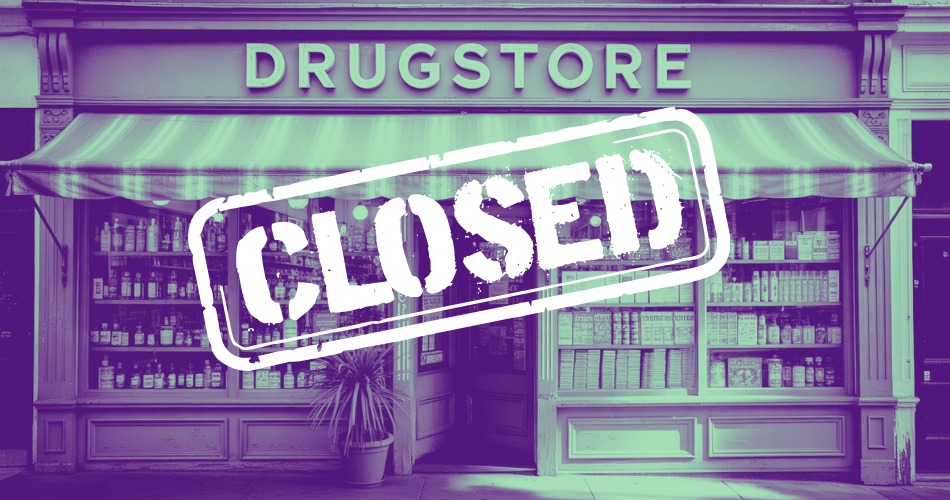
In 2025, one of America’s longest-running pharmacy chains quietly closed its doors for good. After 63 years, Rite Aid filed for bankruptcy, sold off its remaining assets, and shuttered its final stores, ending a once-iconic brand. People, Reuters, and the San Francisco Chronicle confirmed the chain’s liquidation and property sales by early October.
They’re not alone. Walgreens is cutting 1,200 locations over the next three years—roughly 10% of its U.S. footprint—after admitting that one in four stores is unprofitable. Reuters and Healthcare Dive report the closures are part of a cost-containment push to restore profitability. CVS, meanwhile, has closed nearly 900 stores since 2021 and continues to shrink its retail presence.
These aren’t isolated events—they’re symptoms of systemic fragility. When leverage, growth, and structure fall out of alignment, even the biggest players can crumble. For small business owners, these corporate collapses aren’t distant headlines. They’re early warnings.
The Anatomy of Corporate Failure
Rite Aid’s unraveling was dramatic but predictable. After years of declining margins and legal liabilities tied to opioid litigation, its debt load became unsustainable. The company filed for Chapter 11 in May 2025, liquidating prescription assets and properties through a court-approved sale to rivals like Walgreens and CVS.
Walgreens faces a similar problem: high fixed costs, heavy debt, and an outdated retail model. Labor, real estate, and insurance costs are rising even as reimbursement rates on prescriptions fall. Online competition and automation from retailers like Amazon Pharmacy further compress margins.
In theory, leverage amplifies returns. In practice, it magnifies fragility. The same financing structures that fueled expansion—leases, bonds, vendor debt—became immovable liabilities once revenue weakened. None of these companies could pivot fast enough. When fixed costs remain high but demand softens, scale stops being an advantage and becomes an anchor.
For smaller firms, the takeaway is clear: leverage without flexibility turns growth into risk. The pharmacy giants weren’t undone by competition—they were undone by design.
Why Big Doesn’t Always Mean Durable
Expansion is seductive. More stores, more employees, more revenue, which are all signal success. But scale without resilience is a false victory. For Walgreens, CVS, and Rite Aid, every new store added cost, complexity, and exposure. Each required staff, logistics, compliance, and capital investment. A small inefficiency replicated across 9,000 stores becomes an existential problem.
When those inefficiencies compound, slow inventory turnover, labor strain, or rising rents, they cascade through the system. What’s left are assets that look valuable on paper but can’t generate liquidity when needed. Rite Aid’s real estate and brand equity evaporated almost overnight because the underlying model couldn’t sustain them.
For small businesses, the lesson is simple but vital: revenue growth and durability are not the same thing.
Scale magnifies everything, both profits and flaws. Without margin buffers, process discipline, and adaptive systems, growth can accelerate collapse instead of preventing it.
A Small Business Playbook: Design Before You Grow
Resilient companies aren’t built in good times—they’re designed to survive bad ones. Owners who want to protect their businesses from shocks can apply these same principles on a smaller scale:
- Run stress tests regularly. Model a 20–30% revenue drop. Identify which costs, contracts, or accounts payable would strain first—and preempt the failure points now.
- Prioritize stabilizing assets. Recurring revenue, service contracts, and high-margin lines of business are your ballast. Cut or consolidate activities that drain cash or rely on seasonal demand.
- Build modular systems. Avoid single points of failure in your operations. Design processes so one department’s problem doesn’t ripple through the rest of the business.
- Protect liquidity. Cash reserves, revolving credit, and deferred capital spending create breathing room during downturns. Liquidity isn’t laziness—it’s survival fuel.
- Align structure with strategy. Legal and financial frameworks should support flexibility. The wrong structure can trap cash, limit ownership transitions, or inflate tax exposure at the worst possible time.
As the pharmacy sector learned, resilience isn’t about doing more—it’s about designing better.
Conclusion
The fall of household names like Rite Aid, Walgreens, and CVS underscores a hard truth: scale is not a shield. In today’s economy, fragility often hides behind size and familiarity. The lesson for small business leaders is to design for stress before it arrives.
When structure, leverage, and liquidity align, a business can absorb pressure without breaking. When they don’t, collapse is just a matter of timing.
The giants fell not for lack of effort, but because their systems were perfectly designed for the wrong outcome. The same test is coming for everyone else. The smart leaders will prepare before it hits.
Sources





